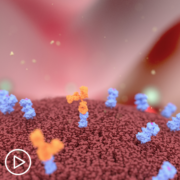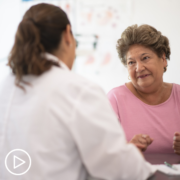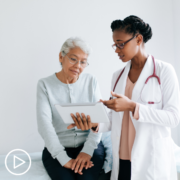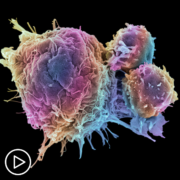Care Partners | What Should You Know About the Bispecific Antibody Treatment for Myeloma?
Care Partners | What Should You Know About the Bispecific Antibody Treatment for Myeloma? from Patient Empowerment Network on Vimeo.
What are care partners essential when a loved one is undergoing bispecific antibody therapy for myeloma? Nurse practitioner Alexandra Distaso from Dana-Farber Cancer Institute explains the bispecific antibody process, reviews potential patient side effects, and shares resources that can help support care partners.
Alexandra Distaso, MSN, FNP-BC is on the Multiple Myeloma Nursing Team at Dana-Farber Cancer Institute.
See More from the Care Partner Toolkit
Related Resources:
Transcript:
Katherine:
Hello and welcome. I’m your host, Katherine Banwell.
Being a care partner can be a demanding role. From understanding a loved one’s diagnosis to participating in treatment decisions, navigating care with a loved one can be challenging. That’s why the Patient Empowerment Network created the Care Partner Toolkit series to provide care partners with advice and information so that they can feel empowered and confident during the process. In today’s program, we’re going to learn about bispecific antibodies, how this myeloma approach works, who it’s right for, and the important role that care partners play throughout the process.
Before we meet our guest, though, let’s review a few important details. The reminder email you received about this program contains a link to program materials. If you haven’t already, click that link to access the guide to help follow along during the webinar. At the end of this program, you’ll receive a link to a program survey. Please take a moment to provide feedback about your experience today in order to help you plan future webinars. And finally, before we get into the discussion, please remember that this program is not a substitute for seeking medical advice. Please refer to your healthcare team about what might be best for you.
Well, let’s meet our guest, nurse practitioner Alexandra Distaso. Alexandra, welcome. Would you please introduce yourself?
Alexandra:
Hi, Katherine. Thank you for having me. Yes, my name is Alexandra Distaso. I am a nurse practitioner at Dana-Farber Cancer Institute in Boston. I’ve been a nurse practitioner for just about nine years, and I’ve been at Dana-Farber for eight of those years.
Katherine:
Well, thank you so much for joining us today. I’m looking forward to having a discussion with you. Alexandra, you work with myeloma patients and their care partners on a regular basis. What is your role on the healthcare team?
Alexandra:
Yeah, so as a nurse practitioner, I’m seeing patients every day in the clinic that I’m here. And we’re seeing patients for both their kind of monthly check-in visits prior to treatment, sick visits, symptom management visits. So, either that’s once a month for your routine visit, or a couple of times a month if you’re going through a transition of treatment or having some sort of side effects we need to work on a little bit more closely.
Katherine:
Well, as I mentioned today, we’re going to be focusing on bispecific antibody therapy. It’s a relatively new approach. What is it exactly?
Alexandra:
Yeah. So, bispecific antibodies are a really exciting new therapy in myeloma that we’ve had for within the last year.
So, we have three bispecific antibodies that are currently approved right now. And the way that they work is, the medication binds to the tumor site on your plasma cell, where the myeloma cell is, and it binds to a T cell, which is your immune system cell. And it kind of works to redirect the T cell, your immune system, to kill off the cancer cells in your body.
Katherine:
Okay. How has this treatment impacted the state of myeloma treatment and care?
Alexandra:
This has been a great option for patients who are now triple-class refractory and further into their myeloma journey. The development of these new drugs represents really kind of a new era in myeloma. We’re having a lot of patients who are now exposed to more therapies with using three or four drug therapies in the first-line setting. So, having an extra line of therapy now further down the road has been a great option for a lot of patients.
Katherine:
Well, who is this treatment approach approved for, and what are the eligibility requirements?
Alexandra:
So, one thing that’s great about bispecific antibodies is that there is not a lot of restriction on who we can use these therapies for. So, these are great for patients who are a little bit more frail or maybe aren’t up for something like a CAR T, or whose disease is a little further along, and they don’t have time to wait for something like CAR T, which requires collecting of cells and manufacturing. What’s great about these medications is that they’re off the shelf. They’re ready to go kinda when you need them. There are restrictions in terms of how many lines of therapy that you need to have had before you can currently get bispecifics.
So, right now, you need to have four prior lines of therapy, and that needs to include an immunomodulatory agent. So, something like a lenalidomide (Revlimid) or a pomalidomide (Pomalyst), a proteasome inhibitor like bortezomib (Velcade), and a monoclonal antibody like daratumumab (Darzalex) before you’re eligible for these.
Katherine:
Have there been any recent bispecific antibody research developments that patients should know about?
Alexandra:
So, there are at least three bispecific antibodies that are hopefully coming into approval in the next several months to year, cevostamab being one of them. It’s a very exciting time for myeloma with all of these medications being approved. Teclistamab (Tecvayli), elranatamab (Elrexfio), and talquetamab (Talvey) in the last year. There’s still a lot of research on bispecific antibodies, especially trying to bring them all outpatient instead of just having inpatient treatment, and in addition, looking at them with other medications, such as teclistamab with daratumumab.
Katherine:
Okay. Well, thank you for that, Alexandra. This gives us a good idea of what the therapy is, and how it works to treat myeloma. So, let’s dive into the process. How is this treatment administered, and what’s the frequency?
Alexandra:
So, currently, all of the bispecifics are given as subcutaneous injections.
And all of them do require a current hospitalization visit, somewhere between four and 10 days, depending on which medication you’re getting and what schedule you’ll be on. So, everyone is required to be in the hospital. Again, we’re trying to move that outpatient to minimize patients’ times in the hospital if we have to. And you get a lower dose with that first exposure to each of the medications, and then we build up the dose for the doses in the hospital into what will eventually be your outpatient weekly, or biweekly dosing.
Katherine:
Okay. Are there only certain medical centers that have this therapy? How widely available is it?
Alexandra:
So, right now, the step-up dosing, the inpatient hospitalization part of bispecifics is primarily only at academic medical centers. So, it is a little bit more restricted in that initial therapy. But what we are seeing is that a lot of the community practices are able to enroll and give these medications in the community.
So, some patients will come see us for a consult and the initial step up, but then they’re able to go back to their primary team after the first cycle so that they’re not commuting back and forth to Boston all the time.
Katherine:
That’s good to know. So, once the therapy has been given to a patient, what happens next?
Alexandra:
When you’re admitted for these initial step-up dosings, we closely monitor you for reactions in the hospital. That’s why we kind of are doing this in in-patient settings to monitor very closely for CRS and neurotoxicity, which we’ll talk about a little bit later. While you’re in the hospital, they’re checking your labs every day, they’re monitoring your vital signs, they’re doing silly questions like, “Do you know your name and the year,” to kind of monitor how you’re functioning. Once you have passed kind of the step-up dosing, either you’ll come back to me and your primary team at Dana-Farber, or we’ll communicate with your local team to set up your schedule for moving forward.
Katherine:
What are the short-term side effects associated with bispecific therapy?
Alexandra:
Yeah. So, the short-term side effects that we’re watching for are these reactions in the hospital called CRS, cytokine release syndrome, and neurotoxicity.
So, the CRS is an inflammatory response where cytokines are released and usually cause a fever. We monitor and make sure that the fever isn’t being caused by some sort of infectious process or there’s no other cause for the fever. And if not, then there are medications we can give to help reverse these side effects while you’re in the hospital.
So, the way that we treat that is, again, we’ll make sure that there’s no sort of infection or other reason for a fever. And if the patient continues to have the fevers and they have low blood pressure and changes in their oxygen needs, which is kinda what happens if this inflammation progresses, is we’ll give things like dexamethasone, a steroid, or another medication called tocilizumab to help kind of reverse the effects of the cytokine release.
Katherine:
Who else is on the healthcare team when someone receives these therapies?
Alexandra:
Yep. So, you’ll always meet with your oncologist or an oncologist at the academic medical center where you’re going to be getting the medication to go over potential side effects, what the treatment entails, and consent. We have nurses here that are specific to bispecific antibodies, that help coordinate with your local team if you’re going back to your local practice. We have the infusion nursing team who are the ones who are actually giving the bispecific antibody therapies. They explain kind of what to watch for at the site where the injection goes. And then we have pharmacists who are also available to meet with you and go over any questions you may have about the treatment.
Katherine:
What do we know about long-term side effects? Are there any?
Alexandra:
So, long term, what we’re really seeing is risk for infections. So, all of these medications lower your blood cell counts, and we have to watch for these opportunistic infections, fungal, bacterial, viral.
Which is why it’s important that we have everyone on supportive medications to try and prevent that from happening. But long term, that is certainly something that we’re seeing. With the talquetamab, there can also be some skin and taste changes, and those are not necessarily right at the inpatient dosing, but we can see that. But those are things we’re also managing in the months after the initial therapy.
Katherine:
Okay. Why is it so important that care partners let the healthcare team know of any changes that they see in their loved ones?
Alexandra:
I say this to my patients and their families all the time. They know their family member best, and they may be one to notice that they’ve been more tired, or their energy just isn’t the same, or they do have a little cough that maybe the patient hasn’t even really noticed. And those are all things that we want your observation, we want you to speak up about, because the sooner we address some of these problems, the less complications the patients may have.
Katherine:
What are the supportive medications for somebody who might be having side effects?
Alexandra:
Yeah, so with the talquetamab, which we’re primarily seeing a lot of skin side effects and mouth discomfort, a lot of the time we have special mouthwashes to prevent discomfort and irritation. Things like biotin to just keep the mouth moisturized. Steroid creams and nail ointments to help with sometimes some peeling of the skin. And then for all bispecifics, we have everyone on viral prophylaxis. Something like acyclovir (Sitavig or Zovarax) or valacyclovir (Valtrex). PJP prophylaxis. So, something like sulfamethoxazole and trimethoprim (Bactrim) or dapsone (Aczone). And almost all of our patients are on an IVIG infusion once a month to help support their immune system and prevent against infections.
Katherine:
Alexandra, you mentioned care partner looking for a cough, for instance, in a patient. What other things should care partners be looking for?
Alexandra:
Any kind of change in the patient’s baseline is always helpful to know. So, if people are feeling much more tired, even if you’re not due for your therapy, sometimes calling to say that they just don’t seem themselves, we can check their blood counts. And again, sometimes they might need a blood transfusion, or their white count might be quite low, and they might need some Neupogen or filgrastim to help kind of support their blood counts. So, really kind of notifying us, even if it doesn’t seem like a big thing, it’s always better to call.
Katherine:
Yeah. How long will a patient be on a therapy like this?
Alexandra:
So, we still don’t know exactly the long-term duration of response. I think the most recent update we have was a median of 18 to 22 months was the last report. Which is a great response for what we have in myeloma.
Katherine:
So, does the length of time a patient is on a therapy depend on the patient themselves, their comorbidities, et cetera?
Alexandra:
Sometimes they’re comorbidities, but it is usually more just how their myeloma responds. So, every month when you’re coming in for therapy, even if your therapy is weekly or biweekly, every month, we’re monitoring your myeloma markers, and every month we’ll go over those markers to make sure we’re still seeing a good response. Usually, we’ll do a PET scan or a skeletal survey to also monitor everyone’s bones and any other lesions, they may have.
Katherine:
What is considered an ideal response?
Alexandra:
An ideal response. A lot of times we’re seeing everyone’s light chains go to even an undetectable level. So, even if we see some partial responses where the light chains were, let’s say they were 100 and they’re going down into the normal range, that’s still wonderful.
If it stayed like that for months, we wouldn’t make any changes. But best-case scenario, we see them go to a level that we can’t detect them in the blood work.
Katherine:
As I mentioned, Alexandra, this program is aimed at helping care partners understand the process and how they can support their loved ones. What do you feel is the care partner’s role?
Alexandra:
I feel like the best way for care partners to support patients is to kind of take the time to learn about the myeloma and the therapy and try to do the best they can to just be there for not just moral and emotional support, but the other little things that they may need. Coordinating rides, if it’s a family member, asking friends for help.
And then other things like insurance phone calls can be incredibly time-consuming and taxing. Or waiting at the pharmacy to pick up medications. Any, even little things like that, I think take a huge load off the patients who are doing this day in and day out.
Katherine:
Yeah. Are there key questions that care partners should ask as they begin the process?
Alexandra:
I think the best thing that patients and caregivers can do is if they have questions prior to the visit is to make a list. ‘Cause, I’m guilty of this myself, as soon as I show up at my doctor’s office, I completely forget what I wanted to say. So, making a list prior to the appointment, I think, is hugely beneficial. And then I don’t think that it’s ever a bad thing to ask for the doctor or nurse practitioner or pharmacist, whoever you’re meeting with, to see if they can repeat themselves. We’re putting a lot of information into a very short period of time.
And to try and keep track of, again, schedule, supportive care medication, when you’re going to need to be in the hospital, how long, what your follow up will be, taking notes during the visit or asking to hear it again is always helpful. Not even just for the caregiver, but sometimes for the patient who’s still trying to wrap their head around some of the change in therapy.
Katherine:
Right. Yeah. That’s really good advice. As we’ve covered, it’s not always easy being a care partner. What would be your best advice for those who are caring for someone undergoing bispecific antibody treatment?
Alexandra:
I would say it’s hard to put out how important care members are to the entire care team. Again, not just for the logistical, getting the patients to appointments, getting their medication, but really having someone the patient feels comfortable to be able to lean on. And again, they may say, “I’m so overwhelmed in these visits, and I really need some help.
Could you ask these things?” Helping them keep track of all these medication changes and appointments and visits and any sort of even small things like grabbing them a water so that they’re staying hydrated. Those little things make such a difference to people. And I think doing those things, no matter how small they feel, really helps support the patients through these changes in therapy.
Katherine:
Besides yourself, what other staff members can care partners turn to for support?
Alexandra:
So, at our office, we have an amazing group of triage nurses who are available Monday to Friday all during office hours. We have after-hours. If your patient or family member spikes a fever and you’re worried they just don’t look good, there’s always a doctor on 24/7 that you can page to kinda ask for advice and see what to do from there. And again, we have infusion nurses who are giving these injections every day.
And they are wonderful resources on what you might feel later in the day, what that site might look like, side effects that might pop up. So, really, anyone wants to be there to answer questions to make it easier for the patient or the family.
Katherine:
Are there social workers or psychologists on the team as well?
Alexandra:
Yes. We have an amazing group of social workers at Dana-Farber. And one thing that I really like about the way our program is run is that we have a social worker who is dedicated specifically to myeloma. So, they’re very familiar with these medications and the hospitalization requirements, which can be extremely tough. And so having resources and just someone to talk to, both through social work and our psychosocial oncology department, is also a wonderful resource to have.
Katherine:
What about online resources? Do you have any recommendations?
Alexandra:
So, I think that the IMF, the International Myeloma Foundation, and the NCI, have amazing resources for patients.
Actually, the IMF has an entire caregiver support page with kind of caregiver self-help, and ways that you can care for the patient. Care for the caregiver, and care for the patient. I think the MMRF has wonderful resources, and they also have a lot of online forum videos about bispecific antibodies and the different treatments for myeloma that are available if you want to learn more. And then same thing with The Leukemia & Lymphoma Society. Excellent resources online.
Katherine:
Thank you so much for all of that. What about self-care for the care partner? Why is that so important?
Alexandra:
I feel like this is such a hard thing for people because it always gets put on the back burner. And I know a lot of the times it’s like when you’re on an airplane and they say, “Put your oxygen mask on yourself before you put it on anyone around you,” because you can’t help others if you’re running on empty. You really need to take care of yourself.
Make sure you’re not just functioning, that you’re eating and sleeping and hydrating and taking care of all your own personal needs, but also that you’re taking time for you to kind of reflect and have some time to decompress from everything you are trying to do to help your family member or loved one.
Katherine:
Why should care partners speak up and ask questions about how they’re taking care of the patient, what they can do to help the patient and themselves?
Alexandra:
Yeah, I think that these bispecific antibodies are new, and one great thing about them is that overall they are really well-tolerated in general. So, hopefully, it means the patient is feeling pretty good and having a really nice response to their therapy. But if they’re not feeling good, we want you to speak up at home. Again, sometimes patients are the last person that want to tell you there’s a problem ‘cause they’re worried about missing their therapy.
And I always tell patients it’s sometimes not safe, if you do have a cough, if you had had a fever, we want to be safe and maybe hold a dose of therapy to address maybe something else that’s going on and avoid further complications another week. So, if you’re noticing something, I always encourage people to speak up and let us know of any concerns they’re seeing at home.
Katherine:
Alexandra, we received some questions from audience members prior to the program. Amelia wants to know, are bispecific antibodies covered by Medicare?
Alexandra:
I believe they are. I would have to double-check, but I’m fairly certain some of our patients have Medicare and have had bispecific antibodies.
Katherine:
Okay, so for the patient who is getting the bispecific antibody treatment, what are the lifestyle alterations that we as care partners need to make? Any changes to their diet?
Alexandra:
No. I mean, a lot of patients definitely want to maximize anything they can do to make themselves feel better and help their myeloma respond. But what we’ve seen is that there’s not one particular diet or cutting out one particular food that’s going to make a long-term or significant impact on any cancer therapy. The best thing that you can do in terms of diet or lifestyle is to try and just maintain a healthy lifestyle to balance all your other medical needs. You want to make sure your blood pressure is in good control.
You want to make sure if you have diabetes, that your blood glucose is in a good range. Because having those things be in good control is going to make your therapy and potential complications more manageable.
Katherine:
Okay. Can bispecific antibodies cause anemia?
Alexandra:
Yes. So, bispecific antibodies, all of the three that are approved, can cause lower blood counts in all of your blood counts. Red cells, white cells, and platelets.
I will say we’ve usually seen that happen more at the beginning of therapy, and then as patients are on the therapy longer, their counts do tend to recover. So, whether that is from just the initial disease response, or it might be from the cytokine release syndrome, we see low blood counts with that, we don’t always 100 percent know. But it certainly can lower all of your blood counts.
Katherine:
Okay. Gina asks, is there any home equipment we will need to help during treatment?
Alexandra:
Nothing is required. So, you’re not required to have any sort of medical devices at home. Well, I’ll take it back. I would like everyone to have a thermometer so that if you do feel sick, you can at least check your temperature. Sometimes having a blood pressure cuff or an oxygen monitor at home, that can be helpful if you’re not feeling well, just to see if things are out of range. But there’s definitely not a requirement for those things at home.
Katherine:
Okay. What can care partners do to help the patient have a more positive outlook during therapy, especially when they’re feeling down and depressed?
Alexandra:
Sometimes I think the best thing that you can do is acknowledge that this is really hard. I mean, changing therapy, having myeloma, going through a hospital stay is really challenging. And sometimes patients just need to hear, “This is a really hard situation, and you’re doing a great job. Taking all your medication, going to the hospital for these treatments, coming to your follow-ups.” Even those small things, giving encouragement and acknowledging how hard that is, even if it seems like it’s not a big thing, can really give a patient a different perspective on how things are going.
Katherine:
Are there support groups specifically for care partners?
Alexandra:
We do have a care group, a support group here at Dana-Farber that is for care partners, run by our social work team. I think it is both now virtual and live, but I’m not positive if they’ve gone back to in-person support groups yet. But I do think the American Cancer Society has some good online groups as well.
Katherine:
Okay, that’s good to know. Thank you. So, before we end the program, Alexandra, I’d like to get your thoughts about the topic. What message do you want to leave the audience with?
Alexandra:
I would tell them that bispecific antibody therapies are a great option for patients in the current myeloma setting. I know that being in the hospital for a week is an incredibly big ask, especially after everything patients are going through with their treatments and then having their disease progress. But the inpatient stay for the long term, hopefully, outpatient benefit of a quick injection every other week with minimal toxicity is certainly worth it. And so I would try to keep an open mind about bispecifics and get excited about them.
Katherine:
Thank you so much for joining us today, Alexandra. We really appreciate it.
Alexandra:
Thank you so much for having me.
Katherine:
And thank you to all of our partners. If you would like to watch this webinar again, there will be a replay available soon. You’ll receive an email when it’s ready. And don’t forget to take the survey immediately following the webinar.
It will help us as we plan programs in the future. To access tools to help you become a proactive care partner, visit powerfulpatients.org. I’m Katherine Banwell. Thanks for being with us.



















